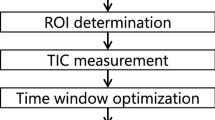Abstract
Pulmonary blood flow is reflected in dynamic chest radiographs as changes in X-ray translucency, i.e., pixel values. Thus, decreased blood flow should be observed as a reduction of the variation of X-ray translucency. We performed the present study to investigate the feasibility of pulmonary blood flow evaluation with a dynamic flat-panel detector (FPD). Sequential chest radiographs of 14 subjects were obtained with a dynamic FPD system. The changes in pixel value in each local area were measured and mapped on the original image by use of a gray scale in which small and large changes were shown in white and black, respectively. The resulting images were compared to the findings in perfusion scans. The cross-correlation coefficients of the changes in pixel value and radioactivity counts in each local area were also computed. In all patients, pulmonary blood flow disorder was indicated as a reduction of changes in pixel values on the mapping image, and a correlation was observed between the distribution of changes in pixel value and those in radioactivity counts (0.7 ≤ r, 3 cases; 0.4 ≤ r < 0.7, 7 cases; 0.2 ≤ r < 0.4, 4 cases). The results indicated that the distribution of changes in pixel value could provide a relative measure related to pulmonary blood flow. The present method is potentially useful for evaluating pulmonary blood flow as an additional examination in conventional chest radiography.






Similar content being viewed by others
References
Hansen JT, Koeppen BM. Cardiovascular physiology. In: Netter’s atlas of human physiology (Netter basic science). Teterboro: Icon Learning Systems; 2002.
Heyneman LE. The chest radiograph: reflections on cardiac physiology. Radiological Society of North America. Scientific Assembly and Annual Meeting Program 2005; 2005. p. 145.
Felson B. Chest roentgenology. Philadelphia: W B Saunders Co.; 1973.
Goodman LR. Felson’s principles of chest roentgenology. A programmed text. 3rd ed. Philadelphia: W B Saunders Co.; 2006.
Tanaka R, Sanada S, Fujimura M, Yasui M, Nakayama K, Matsui T, et al. Development of functional chest imaging with a dynamic flat-panel detector (FPD). Radiol Phys Technol. 2008;1:137–43.
Silverman NR. Clinical video-densitometry. Pulmonary ventilation analysis. Radiology. 1972;103:263–5.
Silverman NR, Intaglietta M, Tompkins WR. Pulmonary ventilation and perfusion during graded pulmonary arterial occlusion. J Appl Physiol. 1973;34:726–31.
Bursch JH. Densitometric studies in digital subtraction angiography: assessment of pulmonary and myocardial perfusion. Herz. 1985;10:208–14.
Liang J, Jarvi T, Kiuru A, Kormano M, Swedstrom E. Dynamic chest image analysis: model-based perfusion analysis in dynamic pulmonary imaging. J Appl Signal Process. 2003;5:437–48.
Fujita H, Doi K, MacMahon H, Kume Y, Giger ML, Hoffmann KR, et al. Basic imaging properties of a large image intensifier-TV digital chest radiographic system. Invest Radiol. 1987;22:328–35.
Tanaka R, Sanada S, Fujimura M, Yasui M, Tsuji S, Hayashi N, et al. Pulmonary blood flow evaluation using a dynamic flat-panel detector: Feasibility study with pulmonary diseases. IJCARS. 2009;4:445–9.
International basic safety standards for protection against ionizing radiation and for the safety of radiation sources. Vienna: International atomic energy agency (IAEA); 1996.
Xu XW, Doi K. Image feature analysis for computer-aided diagnosis: accurate determination of ribcage boundary in chest radiographs. Med Phys. 1995;22:617–26.
Li L, Zheng Y, Kallergi M, Clark RA. Improved method for automatic identification of lung regions on chest radiographs. Acad Radiol. 2001;8:629–38.
Myers PH, Nice CM, Becker HC, Nettleton WJ, Sweeney JW, Meckstroth GR. Automated computer analysis of radiographic images. Radiology. 1964;83:1029–33.
Rees D. Essential statistics. 4th ed. Florida: Chapman & Hall; 2001 (Text in statistical science).
Acknowledgments
The authors are grateful to Naoki Kikuchi and Atsushi Kameoka at Marubun Tsusho Co., LTD, and Masaaki Kawamura, Tomoyuki Yamamoto, and the technologists of the Dept. of Radiology, Kanazawa University Hospital, who assisted with data acquisition. The authors thank the editors and reviewers who spent a great deal of time and gave us informative advice for improving our manuscript. This work was supported in part by a Grant-in-Aid for Scientific Research from the Japanese Ministry of Education, Culture, Sports, Science, and Technology, Konica Minolta Imaging Science Foundation, Suzuken Memorial Fuoudation, and Japan Science and Technology Agency.
Author information
Authors and Affiliations
Corresponding author
About this article
Cite this article
Tanaka, R., Sanada, S., Fujimura, M. et al. Development of pulmonary blood flow evaluation method with a dynamic flat-panel detector: quantitative correlation analysis with findings on perfusion scan. Radiol Phys Technol 3, 40–45 (2010). https://doi.org/10.1007/s12194-009-0074-1
Received:
Revised:
Accepted:
Published:
Issue Date:
DOI: https://doi.org/10.1007/s12194-009-0074-1




